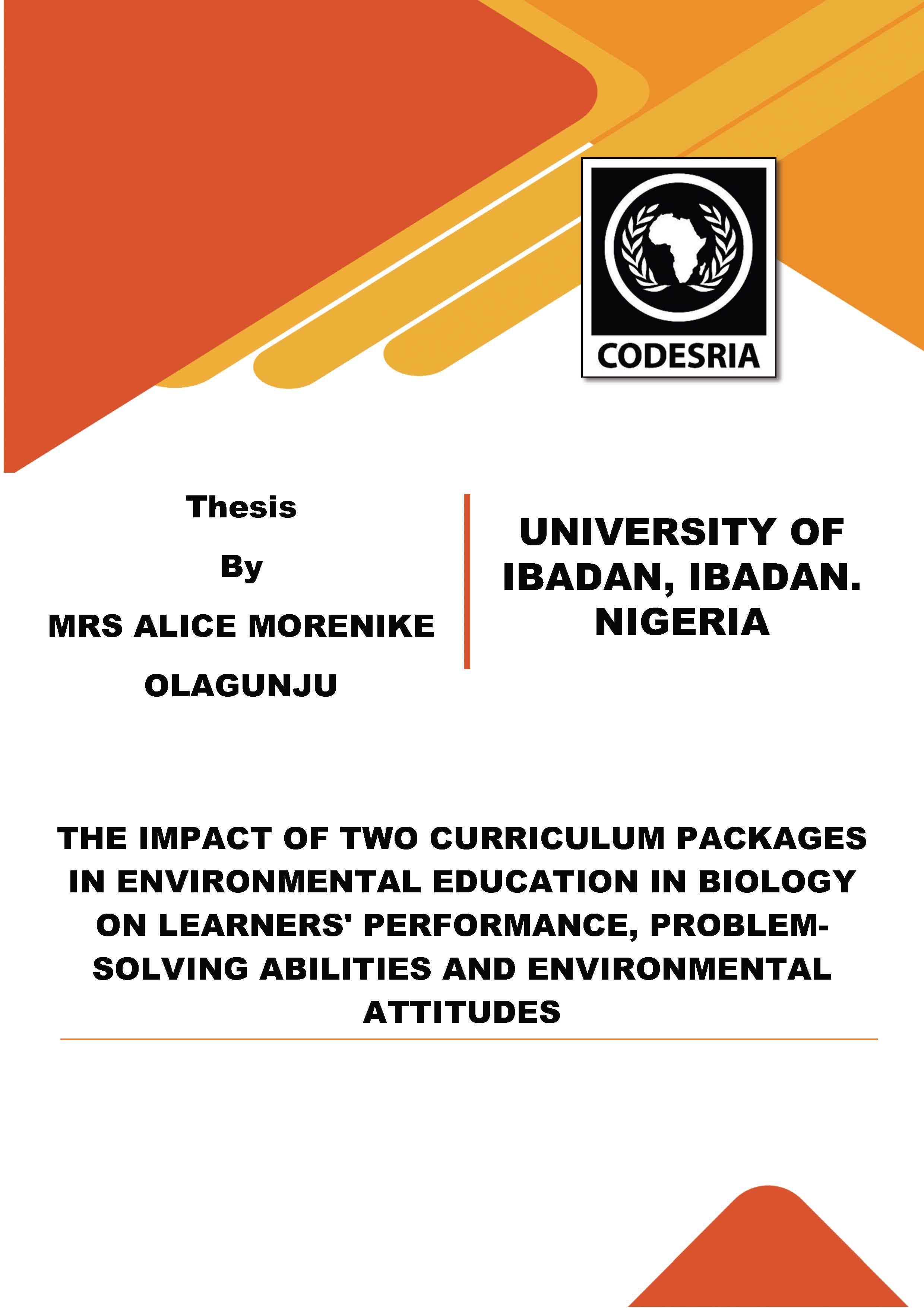THE IMPACT OF TWO CURRICULUM PACKAGES IN ENVIRONMENTAL EDUCATION IN BIOLOGY ON LEARNERS' PERFORMANCE, PROBLEMSOLVING ABILITIES AND ENVIRONMENTAL ATTITUDES
Mots-clés :
EDUCATION, BIOLOGY, LEARNERS' PERFORMANCE, ATTITUDESSynopsis
This study investigated the impact of two curriculum packages in environmental education (Environmental Educationand Conventional Modules) in Biology gender and subject specialization on students' performance, problem-solving abilities and environmental attitudes.
The subjects involved in the study consisted of 347 senior secondary two science and non-s.cience students (177 Experimental and 170 Control) in twelve intact classes randomly selected from six senior secondary schools in Ibadan Municipality of Oyo State. A pre- test, post-test control group quasi-experimental design was adopted for the study. The four instruments used
to collect data were: students' Attitude to Environmental Conservation Questionnaire (S.A.E.Q.) with Cronbach alpha measure of 0.90; Test on Environmental Conservatiori Knowledge in Biology (T.E.C.K) with KR(21)-Kuder Richardson reliability index of 0.92; Test of Problem-solving Achievement in Environmental Conservation (T.P.S.S.) with KR ( 21) Kuder Richardson reliability index of 0.85; Environmental Education Module (E.E.M.) and the Teacher's Instructional Guide on E.E.M(T.I.G.E.) which were pilot tested and validated, with Pearson r = 0.97.
The experimental subjects were exposed to the Environmental Education Module (Package) by trained teachers while the control groups were taught the conventional (existing) biology curriculum by their regular teachers for six weeks at an average of three periods per week. The data collected. were analyzed using descriptive statistics (mean, standard deviation) and inferential statistics (Analysis of Covariance and t-test). Seven hypotheses were tested at 0.05 level of significance.
The major findings include:
1. Students taught using the E.E.M. performed significantly better in their cognitive achievement [F(l,345) = 3680.317, P < .05]; problem-solving achievement [F(l,345) = 3189.326, P < .05]; and environmental attitudes [F(l,345) = 3134.800; P < .05] than students who were not exposed to EEM materials.
2. There was no significant main effect of gender on students' cognitive achievement [F(l,345) = 0.65, P > .05] problem-solving achievement [F(l,345) = .127, P > .05] and environmental attitudes [F(l,345) .886, P > .05] toward resolving conservation issues and problems.
3. The students' subject specialization had a significant main effect on students' cognitive achi.evement [F (1,345) = 22.205, P < .05] and environmental attitude scores [F(l,345) 14.944, P < .05], but with no significant effect on students' problem-solving achievement [F(l,345) = 2.414, P >. 05] .
4. There was no significant interactive effect of treatment and gender on students' cognitive achievement [F(l,345) 3.027, P > .05]; problem-solving achievement [P(l,345) .504, P > .05] and environmental attitudes [F(l,345) = .177, P > .05].
Sa Significant interactive effects of treatment and subject specialization on students' cognitive achievement [F(l,345) = 18.300, P < .05] and environmental attitude scores [F(l,345) = 4.507, P < .05] were obtained.
b The subjects' problem-solving achievement was not significantly influenced by subject specialization and treatment [F(l,345) = 2.143, P > .05],
6 The subjects' gender and subject specialization did not exert any significant interactive effect on students' cognitive achievement [F(l,345) 1.046, P > .05]; problem-solving achievement [F(l,345) = 2.147, P > .05] and environmental attitude scores [F(l,345) = .299, P > .05].
7. There was no significant interactive effect of treatment, gender and subject specialization on students' cognitiveachievement [F(l,345) = 1.675, P > .05]; problem-solvingachievement [F(l,345) = 0.002, p > . 0 5] ; and environmental attitudes [F(l,345) .008, P > .05].
In the light of these findings, it could be inferred that the Environmental Education Module was effective in enhancing subjects' attainments.
These findings showed the need to incorporate this newly developed curriculum (EEM) as a viable instructional material in its environmental components in Biology. This will help to promote the level of students' cognitive achievement, problemsolving abilities and the right attitude to conserve our natural environment, in the country's stride for sustainable development.
Téléchargements
Références
Westerman, M. & Griner, J.R. (1991). Making Camp Environmentally Friendly: How Camps Did It. Camping-Magazine; 65(5), 20-25.
Westphal, J.M. & Havers on, W. F. ( 1985/86) . Assessing the LongTerm Effects of an- Environmental Education Program: A programmatic Approach: International Journal of Environmental Education, 17(2) 26-30. Wheeler, D.K. (1983) Stoughton Ltd.
Curriculum Process: London: Hodder and Wilson, R.J. & Tamera, A.N. (1980). Enriching Traditional Biology with an Environmental Perspective. Journal of Environmental Education, 12 (1)
Winslow, D.R. (1981) The Current Status of Education in Indiana. Hoosier Science Teacher Environmental .2_(3) / 93-96.
Woodford, C.M. & Lass, N.J. (1993). Noise Exposure and Hearing Loss in Rural Children. Rural Educator, 15(1), 14-16.
World Bank Report (1990). Nigeria's Environmental Balance Sheet. In Noibi, Y & Lawal T. (1993): Training and Education for Conservation & Sustainable Development. 1st National Conference of EE Proceedings, NCF/WWF, pp 28.
Yoloye, E.A. (1982). "Major Considerations for Developing environmental Education" in Atchia, M. (ed) Environmental Education in the African Schools Curriculum., Ibadan. A.C.O. Monograph series, No. 2, pp 38-46.






